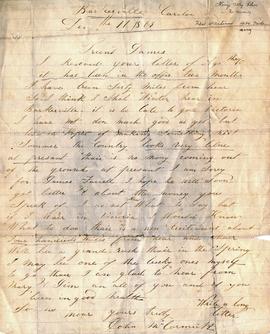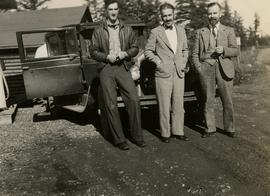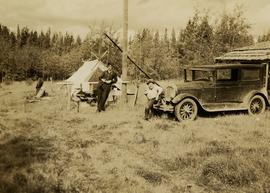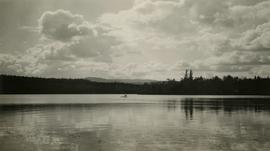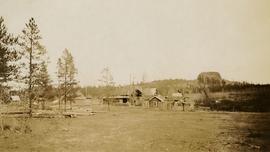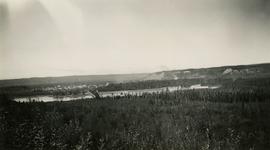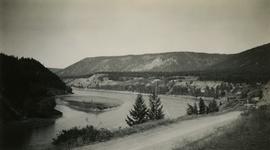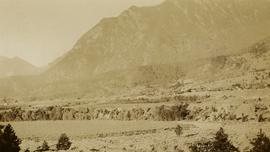Subseries includes research material created and collected by Kent Sedgwick relating to land survey, development, and settlement in Prince George and British Columbia. Land surveys were conducted in British Columbia by surveyors George Dawson, the North Coast Land Company, Alfred R.C. Selwyn, and the Geological Survey of Canada during the late 19th and early 20th centuries. James C. Anderson and engineer J. Gill conducted topographical surveys for the Grand Trunk Pacific Railway on Fort George and the Indian Reserve. Surveyors and land plot companies developed the land for sale to promote settlement in the area. Also includes materials regarding the continued development of the City of Prince George throughout the 20th century. The files primarily consist of newspaper clippings, research notes, and photocopied documents.
The item is a reproduction of a survey map drafted in January 1910. The reproduction was likely created in 1990. The subdivision is Lot 936 G. I. Cariboo District, B.C. The area covered is North of Twenty First Avenue, East of Quinn Street, South of Eighth Avenue and West of Carney Street. Annotations highlight "Owner Edgar McMickiny," "696" and "Jordan Brothel" written in red pen pointing to a specific location.
The item is a reproduction of a survey map drafted in September 1909. The reproduction was likely created in 1990. The annotations highlight owners of different lots up to approximately 1959. Th area covered is North of Fifteenth Avenue, East of Irwin Street, South of Eighth Avenue and West of Carney Street. Annotations on attached papers indicate different means of scale and measurement for the map.
The item is a reproduction of a survey map likely drafted in the 1910s. The reproduction was likely created in 1990. The area covered is South of Anderson Street, East of Simpson Street, North of Van Bien Avenue and West of 9th Street. Annotations state, "Pl 721 DL 1426."
The item is a reproduction of a survey map drafted on 1 March 1910. The reproduction was likely created in 1990. The area covered is South of Bernhardt Avenue, East of Simpson Street, North of the Fraser River and West of 9th Street. Annotations state, "DL 1426 Plan 721."
The item is a reproduction of a survey map drafted in 1909. The reproduction was likely created in 1990. The area covered are lots 931 and 417. Annotations state, "Plan 701," and various names are highlighted.
Item consists of a letter documenting Johns McCormick’s experiences at Williams Creek in Barkerville during the winter of 1869. He describes the poor gold mining conditions on Williams Creek and his hopes for future prosperity.
File consists of reproduced copy of "To the Memory of Alexander Mackenzie's Granddaughter and last Descendant Mrs. Heald (Alexandra Isabel Mackenzie)" originally published in 1933.
File consists of maps depicting the Salmon River Portage area.
File consists of notes and reproductions relating to Salmon River Portage surveys.
File consists of notes and reproductions relaintg to the Willow River townsite.
File consists of notes and reproductions relating to the Stewart River townsite. Includes photographs depicting newspaper articles about the Stuart River.
File consists of notes and reproductions relating to the Vanderhoof and area townsites. Also includes a map depicting the South Hazelton townsite before 1980.
File consists of notes and reproductions relating to Mud River Elementary School. Also includes photographs depicting old Mud River buildings and roads.
File consists of notes, clippings, and reproductions relating to the community of Shelley.
File consists of notes, clippings, and reproductions relating to Woodpecker and Hixon. Includes: "Heritage Week" poster with photographs depicting Huble Homestead, Valemount Museum, St Mark's Anglican Church, and the Church of St Pius X (Feb. 1994). File also includes photographs depicting various buildings in Woodpecker and Hixon, including the Woodpecker Church (2001).
File consists of notes and reproductions relating to immigration to British Columbia between 1910 and 1915. Includes material regarding James Mackay, an immigrant from Scotland who came to Canada in 1912, and his wife Dorothy Mackay; and passenger lists for immigration to Canada.
File consists of notes and reproductions relating to the Duke of Sutherland. Also includes photographs depicting the area of White's Landing in Strathnaver (2010).
File consists of notes and reproductions relating to the MacKay family in Strathnaver, British Columbia.
File consists of notes and reproductions relating to the 4th Duke of Sutherland in the Cowichan Valley. Also includes photographs depicting the Cowichan Valley (Mar. 2007).
File consists of notes and reproductions relating to Innisfail, Alberta and the 4th Duke of Sutherland.
File consists of notes and reproductions relating to the 4th Duke of Sutherland's background in Scotland.
File consists of notes and reproductions relating to the 5th and 6th Dukes of Sutherland.
Photograph depicts (from left to right) Gordon Wyness, Louis LeBourdais, and Earl Malcolm (owner of Quesnel Hotel) standing in front of a 1930 Buick Series 40 car at Twilight Lodge in Lac La Hache, BC. The group was preparing to leave for Prince George.
Photograph depicts (from left to right) Gordon Wyness and Jack Lee at a camp scene "at Bobtail" (possibly Bobtail Lake) near Vanderhoof. As noted in the album caption, the crew had "just returned from Vanderhoof". The telegraph cabin roof and their 1930 Buick Series 40 car is visible at right.
Photograph depicts Jack Lee rafting with a sail on Bobtail Lake, as he was going over to other side of the lake to locate traverse posts (without success, according to the annotation on the photograph verso).
Photograph depicts a view of Lone Butte, BC. The butte formation of the same name (Lone Butte) is visible in the background; a ranch or residence is visible in the foreground. Wyness notes that Lone Butte was the "last one [they] tied in". "Tying in" is a land surveying technique. Since the photograph is dated October 1936 and Wyness described the survey trip as lasting June 5 - October 8, 1936, that implies that Lone Butte was the last location they surveyed on this trip.
Photograph depicts a view of the city of Prince George looking west from the east hill. The confluence of the Fraser River and Nechako River is visible to the right. The Grand Trunk Pacific Railway bridge is visible at centre. The current location of where this photograph may have been taken is likely somewhere near where Highway 16 rises on the hill past the correctional centre (jail).
Photograph depicts a view of Fraser River from the Soda Creek hill in October 1936. The town of Soda Creek is barely visible at right.
Photograph depicts the town of Lytton in October 1936.
Photograph depicts "The Chasm" or "The Painted Chasm", located 11 miles north of Clinton, adjacent to the route of the Cariboo Road. In 1940, four years after this photograph was taken, Chasm Provincial Park was created in 1940 to preserve and promote the Painted Chasm feature, a gorge created from melting glacial waters eroding a lava plateau over a 10 million year span.
Series consists of records relating to G. Gary Runka's personal life, including academic records, personal resume, and posthumous materials. Also includes Runka's personal correspondence during his time with the Agricultural Land Commission and memorabilia from his curling activities.
File consists of a copy of Gary Runka's resume prior to the creation of his consultancy business G. Gary Runka Land Sense Ltd.
File consists of G. Gary Runka's high school records.
File consists of a 1955 North Peace High School yearbook.
File consists of two Peace River District High School Curling Championship patches.
File consists of a speech given by Gary Runka to the Agricultural Institute of Canada Land Use Committee entitled "Land Use Control and Jurisdictional Rights".
Commentary on this speech by Barry Smith of the Ministry of Agriculture and Lands:
"This is a first draft position paper written by GGR was developed for the Agricultural Institute of Canada, Land Use Committee.
The paper notes that attitudes are shifting from land being considered as a commodity to considering land as a natural resource. There are several references to governmental relationships, the inability to count on local governments to preserve agricultural land and the need for a federal land use policy supporting farmland preservation.
The use of a zoning tool as an effective means to preserve agricultural land is explored. The paper makes a strong case for there being no legal need for compensating land owners for regulatory land use zoning.
Included with the package are two letters written by GGR (November 7,1974) sent to Jim Lore (Alberta) and Steve Hart (Ottawa) requesting their review of the paper and input. A copy of the finalized paper, which may have been a jointly authored paper, is not included and it is not known if the paper was eventually published by the Agricultural Institute of Canada."
File consists of notes written by Joan Sawicki for an untitled pending speech by Gary Runka.
Commentary on this speech by Barry Smith of the Ministry of Agriculture and Lands:
"Despite this being only 4 pages of rough notes, its focus on the initial work of the Commission and challenges of designating the ALR make it an historically important document.
For example it was initially thought the ALR would be guided by class 1 - 4 CLI ratings but this proved impractical in the north and range areas. An additional challenge was that parts of the province only had the benefit of 1:50000 mapping. This presented a very real problem for establishing the ALR.
One concern with this document is that because it is written in point form and consists of rough notes, it could be open to a degree of misinterpretation if not considered by an individual with experience in the administration of the ALR. For a much more refined statement on the B.C. Agricultural Land Preservation program and the designation of the ALR see Items [2020.4.2.1.23, 2020.4.2.1.24, and 2020.4.2.1.25]."
File consists of a speech given by Gary Runka to the B.C.I.A. entitled "Agricultural Land Reserves and the Land Commission Act".
Commentary on this speech by Barry Smith of the Ministry of Agriculture and Lands:
"With the original package associated with this speech are 5 pages of rough notes for another speech with the same title prepared for a B.C.I.A. meeting on March 22, 1976... Given that these rough notes were held with the material associated with the April 15, 1976 meeting it is possible the B.C.I.A. meeting planned for March was shifted to the April date. Additionally there are 6 pages numbered 6-11 that are of some detail concerning the work of the Commission but appear to be part of another speech but are included with the B.C.I.A. package and have, therefore, been [included with this speech].
The title of the speech "Agricultural Land Reserves and the Land Commission Act" sums up the thrust of the speech which notes the objectives of the legislation, the Commission's program of land acquisition and Commission research and support of innovative projects to assist rural planning to create a positive environment for agriculture and give direction to urban growth away from farmland.
Additionally an overview is provided of the Commission's activities in its first two years of operation. GGR comments that establishing the ALRs "... was but a first step and we feel that it is our job to continue to protect the Reserve by whatever approaches and methods of rural planning that are available to us". This speaks to a Commission that saw its role, even at this early stage, as being much more than simply a rationing board reviewing ALR applications.
Several examples are outlined in which it is suggested that professional agrologists should be looking at carefully.
At the end of the speech (p.5) GGR includes (a note to himself) to "follow with example of an agrologist's public statement" that obviously was of concern. The actual public statement was not included with the speech given on April 15th but was included in the rough notes of the speech dated March 22 which read as follows:
"Yet a member of the B.C.I.A. - a P.Ag - is quoted in the press in response to a local politician who asked him a question something like this in regard to an ALR exclusion application:
Local politician: What about the international, national and local concerns regarding land for future food production?
BOA member P.Ag: We should firstly be concerned with places for people to live and secondly worry about land for food production.
This is our profession - the image is yours to make.
I don't mean that we should go overboard, but if we are not willing to defend preservation of agricultural land - who is?"
File consists of notes for an untitled speech about "Experiences at the B.C. Land Commission" by Gary Runka at a Habitat 1976 panel at the United Nations Conference on Human Settlements, Vancouver between May 31-June 11,1976.
Commentary on this speech by Barry Smith of the Ministry of Agriculture and Lands:
"GGR gave this speech as part of a panel at Habitat 1976.
The speech outlines the scope of the legislation, background of a provincial zoning technique (based on technical information), the establishment of the ALR plans in each of 28 regional districts and commentary on some of the projects the Commission is involved with.
Providing context to the land-use planning environment that the B.C. farmland preservation program and ALR were thrust into in the mid-1970s, GGR remarks that:
"In many cases we have local governments making their first real strong attempt at land use planning. Backed by the strength of the Land Commission Act it is seen as a real change to control urban sprawl and linear development that is detrimental from other planning points of view, as well as from the agricultural land point of view."
The fact that GGR was asked to be part of the panel at the first United Nations Conference on Human Settlements speaks to the regard given the B.C. farmland preservation program."
File consists of a speech given by Gary Runka entitled "Vegetable Situation in BC".
File consists of an untitled speech to the Chilliwack Chamber of Commerce regarding land use planning and its impact on the food producer.
Commentary on this speech by Barry Smith of the Ministry of Agriculture and Lands:
"These 3 pages of notes prepared for a speech given to the Chilliwack Chamber of Commerce are packed with several important themes and is a more refined version of [2020.4.2.1.24].
Some of the important themes mentioned include:
- Preserving the option of agriculture in BC will not be accomplished by preserving agricultural land alone;
- Prior to the ALR we were losing our best farmland first;
- BC is attempting to become more self-sufficient in food production;
- BC agriculture is diverse but lacks large volumes of any single commodity;
- Rural areas must be carefully planned to protect food production and not thought of as a storehouse of future urban development;
- With land use planning it is often difficult to see benefits in the short term but losses for a few people should amount to long term gains for many; and
- Several examples are provided of initiatives aimed at protecting rural areas, habitat etc.
The speech notes include the first mention of the work of the Ministry of Agriculture's Greenzone Committee and its efforts to find ways of reducing land use conflicts.
Many of these themes have been considered in previous speeches but are consolidated here and the paper ends with a need for food producers to get involved in land use planning process."
File consists of a speech given by Gary Runka entitled "Private Land Needs and the BC Agricultural Land Commission Experience" for the Perspectives on Natural Resources Symposium II at Sir Sanford Fleming College in Lindsay, Ontario.
Commentary on this speech by Barry Smith of the Ministry of Agriculture and Lands:
"This represents a major, out of province speech. It covers some familiar historic themes concerning the implementation of the BC farmland preservation program but also provides other interesting insights. It includes an informative summary of the land scarcity problem particular to BC.
With the designation of the ALR complete, the much more difficult task is: "... to make the right land-use decisions within the agricultural zone and encourage good land use planning adjacent to it in order to accomplish the stated objectives." This statement clearly establishes the perspective that the ALC is not just focused on land within the ALR but believes its protection mandate extends beyond the bounds of the Reserve.
GGR states that for competing uses there are normally non-agricultural alternatives but: "...the ability and willingness to go in these other directions necessitates a radical change in thinking on the part of governments, private industry, real estate interests, and the general public." Fourteen competing land uses are noted.
It is noted that the ALC Act "...has provided impetus for more formal planning at the local and regional levels..." - a fact all too often missed.
GGR reviews the types of plan policies that will assist the preservation of farmland and support the continued farming of agricultural land.
A number of specific initiatives are noted and mention is made of the urban / rural fringe problems and the work of the Ministry of Agriculture Green Zone Committee. Mention is made of the challenges associated with dealing with conflicts with other provincial and federal agencies.
The paper is summarized with three general approaches to looking at land needs, land uses and resource planning drawn from GGR's personal experience:
- Canada can't afford many more mistakes in the area of land resource allocation and making land-use decisions on the basis of the land's inherent natural characteristics is more reliable and sensible than based on the protection of property values and simply accommodating growth pressures;
- The ALC has learned that every move in rural planning and every decision in resource management has impact upon agriculture; and
- Agricultural land preservation represents a provincial priority and it has identified a direction around which all others can plan.
GGR closes - "In the final analysis, it is the process of planning that is important, the product itself is never quite finalized."
File consists of a speech given by Gary Runka entitled "The BC Agricultural Land Preservation Experience" to the Canadian Agricultural Extension Council Conference in Kelowna.
Commentary on this speech by Barry Smith of the Ministry of Agriculture and Lands:
"This speech represents a major paper that reiterates historical themes concerning the legislative initiative, B.C's very limited area available for agricultural production and the designation of the ALR plans.
GGR emphasizes that the main criteria when considering applications under the ALC Act is the soil/climate capability for agriculture. He mentions that the actual designation of the ALR and its subsequent refinement was fairly straight-forward but: "Much more difficult is the task that we are now facing, to make the right land-use decisions within the agricultural zone and encourage good land-use planning adjacent to it in order to accomplish the stated objectives."
GGR remarks that the ALC Act is based on the assumption that there are alternatives to farmland for urban uses and he personally agrees that alternatives do exist in almost all cases but he cautions: "But, the ability and willingness to go in these other directions necessitates a radical change in thinking on the part of governments, private industry, real estate interests, and the general public. It also demands an acceptance of the fact that agricultural land preservation is in British Columbia to stay and it assumes a commitment to preserve the agricultural industry as being in our own long term best interests. Some vibrations tell me we still have not quite made the grade in this area." These words were spoken by the Chair of the ALC 36 years ago and could be as appropriately be spoken by any of the subsequent ALC's Chairs to this day.
Competing land uses are listed and guidelines on expected policy content in Official Settlement Plans developed under the Municipal Act aimed at the protection of agricultural land and agriculture are noted.
Three examples are provided of studies to explore alternate areas of growth along with work on dealing with impact issues (edge/interface planning). GGR emphasizes the challenge of dealing with other governmental agencies and ends by outlining 3 general approaches to look at land needs, land uses and resource planning:
- Make land use decision based on the inherent natural characteristics rather than protecting land values or simply accommodating growth;
- The Fall 1977 amendments to the Act allowing greater Cabinet involvement will test the program but also emphasizes the importance of shared decision making; and
- The ALC Act has defined a land use priority and a direction around which all others can plan and there is a need for a national land use policy that GGR supports."
File consists of a speech given by Gary Runka entitled "BC Experience: Establishing Priorities for the Use of Rural Land Resources" for the Canadian Institute of Planners Annual Conference in Kitchener, Waterloo.
Commentary on this speech by Barry Smith of the Ministry of Agriculture and Lands:
"This is a second speech GGR gave at the 1980 CIP Conference.
The 'rural' stage is set by stating that BC is 94% crown land of which 53% is unreserved crown land - so lots of rural land to plan for.
The paper largely outlines 8 examples of rural land use priorities in BC including:
- Integrating rural land use policy under the Environment and Land Use Act
- Agricultural Land Commission Act protecting farmland
- Forest and Range Act
- Municipal and Regional government community, settlement and regional plans - largely on non-crown land
- The Federal government's amended Fisheries Act
- Special Statutes Planning - The Islands Trust Act
- Crown land Planning Strategies
- Environment Planning via an Environment Act, Water Basin Plan and Wildlife along with complimentary legislation.
The paper helps to place the farmland preservation in the context with other land use planning efforts in British Columbia."
File consists of a speech given by Gary Runka entitled "Who Gets to Use the Land and Water? - the Urban and Agricultural Land Needs of the Okanagan Valley" for the Faculty of Agricultural Sciences, UBC and Okanagan College.
Commentary on this speech by Barry Smith of the Ministry of Agriculture and Lands:
"Although the ALR and ALC Act are not mentioned directly, the paper is focused on agriculture and rural planning.
When speaking of the competition for land and the pressure agricultural land is under, an interesting statement is included referring to the fact that "the fluctuation" in Washington State's apple crop is greater than the entire annual Okanagan production.
The paper reviews pressures on agriculture and urban land uses. Under "Satisfying the Needs (Options and Interrelationships)" seven points are made including "Understanding the land is the most important prerequisite to its wise and proper use," and that Integrated Natural Resource Management and Land Use Planning must be closely tied.
The paper ends with a point of optimism - "I see that potential to increase our understanding of the natural processes and to explore the questions of who gets to use the land and water from a view point somewhere in the orchard or countryside rather than from Main Street. That's a beginning."
File consists of a speech given by Gary Runka entitled "Planning for the Future Agricultural Land Base of Alberta" for Alberta Agriculture Land Use Activities, Edmonton, June 2,1981.
Commentary on this speech by Barry Smith of the Ministry of Agriculture and Lands:
"This appears to be a set of preliminary speaking notes - much of it is point form with considerable hand written notes in the margins. It is not known if these notes were ever finalized into the speech given on June 2,1981 or if the speech was simply given using these notes as its basis.
Many of the references are somewhat oblique relating to topical matters in Alberta. While agriculture is the central theme, this speech is focused on Alberta with little or no reference to the BC farmland preservation program.
Several broader themes are considered which are dealt with in other speeches but GGR speaks to the longer term importance of farmland preservation legislation when stating (p. 3):
"b) from my experience, time is demonstrating ever more clearly to me that, for a variety of reasons, legislating land preservation alone can only hold the land resource for so long if the other aspects affecting the food producing industry are not also given attention e.g.:
- review of regional planning by the ARB
- costs of production and marketing opportunities
- gov't priority for ag. related to other prov. resources
- urban planning - where are the cites going?
- rural planning - how secure are the rural communities of which agriculture is a part?"
File consists of a speech given by Gary Runka entitled "Effects of Urban Decision Making on Rural Issues".
Commentary on this speech by Barry Smith of the Ministry of Agriculture and Lands:
"The introduction begins by stating that urban-oriented people are making decisions that impact on rural issues and land / people relationships. This paper provides a perspective largely from a rural point of view although, at the very end it is concluded that people in rural areas are often unaware of the dynamics of urban needs and priorities.
While the examples of urban influences on rural areas are too numerous to comprehensively outline even in a 16 page speech, GGR does cover a lot of ground in this regard in the paper. He feels that through careful planning built on understanding we can, as a society, achieve a comfortable balance.
The question is asked, who is rural and who is urban - there is a degree of blurring. The paper considers urban decision-making in the broadest context - whether political, economic or social.
The paper is broken into a consideration of urban decision making and its effects on rural areas from a number of points of view - (1) Political; (2) Economic; and (3) Lifestyle.
It is noted that there is a need for greater understanding of agriculture from both a rural and urban point of view and the spin-offs of food and fibre production in providing jobs in the urban community is not widely recognized by urban citizens or elected officials.
As the number of urbanites take up residence in rural areas their power at the local ballot box also increases. Three examples of urban decision making on rural issues are explored including:
(1) The "Killer" Mall;
(2) The "Suburban" Horse; and
(3) Soil Conservation.
Interdependence is specifically emphasized - there is seldom any decision taken that does not impact to some degree somewhere else along the urban-rural continuum."
File consists of an article written by Gary Runka entitled "Balanced Agriculture - Its Social Value" for the Symposium o n Decoupling, Ottawa - February 10-12,1988.
Commentary on this speech by Barry Smith of the Ministry of Agriculture and Lands:
"This speech was prepared for publication in the July 1988 edition of t he "Canadian Journal of Agricultural Economics".
The Symposium explores the social and economic values of agriculture and this paper primarily pursues the social value side of the equation and asserts that a healthy agricultural sector has a social as well as economic value to Canada.
The paper is broken into four sections:
(I) The Farm;
(II) Rural Communities and Regions;
(III) Canada and Beyond; and
(IV) Summary.
Under these broad topics the paper considers several themes, many of which have a strong or direct relationship to farmland preservation. B.C. and Quebec programs are directly mentioned. A few of these themes are captured here:
- "balanced agriculture" ... let it imply a balance between economic considerations (market forces) and social values
- It is not easy to design legislative programs that will accommodate both the legitimate financial concerns of those who husband the land and the desire of society to protect a scarce resource
- Society must share in t he responsibility to retain foodlands. "...both Quebec and British Columbia accepted this responsibility in their agricultural land preservation legislation by bring in associated commodity income insurance programs along with the provincial designation of land within agricultural land reserve zoning."
- A need for balance between private rights of land ownership with stewardship and the responsibility of government to intervene when private interests do not coincide with public interests.
- The urban majority will have a growing influence on the way farmers and agriculture will be treated in coming decades
- Any country is wise to ensure that it retains the option to produce at least a portion of its own food
- Do we want agriculture driven by a "trade environment" or do we as a country have other social goals that we wish to pursue, of which international trade is part?
- It is in Canadian society's general interest to have economic and social cohesion when considering agricultural policy reform."
File consists of a speech given by Gary Runka entitled "The Importance of Agriculture to BC and the Creston Valley" Creston Valley Agricultural Society.
Commentary on this speech by Barry Smith of the Ministry of Agriculture and Lands:
"The speech begins with a number of recent urban newspaper headlines illustrating the level of awareness and the stress on agriculture.
The paper is broken into several major topics:
(I) The Options - in which two perspectives are outlined - one positive that agriculture has social value and is vitally important to the province and second, that agriculture is ultimately doomed.
(II) The Agricultural Land (Water) Base - 11 different land use planning issues are reviewed from an agricultural perspective. It is stressed that agriculture must become a more integrated part of the overall planning process.
(III) The Economic and Social Well Being of the Farming Community. It is noted that there are strong feelings in rural communities that government bureaucrats impose planning and resource management decisions on them rather than plan with or for them. Thus, if agriculture is to thrive it must, once again, become a more integrated part of the overall planning process and the agricultural land base must be assured.
(IV) The Ecological and Economic Sustainability of Agriculture - A key agricultural land conservation measure will be the redirection of regional and local urban growth to available and suitable lands outside the ALR. Provincial and local zoning is seen as a first step framework for managing competition for agricultural land.
Betterment Recapture - this (possibly Henry George inspired) comment reflects the need to recapture a portion of the appreciated value when agricultural land is converted to urban uses as a hedge against speculative forces.
The paper ends by encouraging farm areas like the Creston Valley to take pride in their agricultural community because the opportunity exists for a vibrant, healthy sustainable future."
